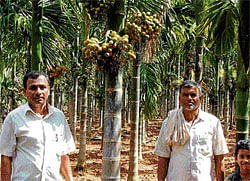Future tense for arecanut growers in Davangere

Arecanut is the main ingredient that goes into the manufacture of gutkha and the apex court is likely to pronounce the verdict shortly. Yet, they are preparing for the worst and want to switch to an alternative crop if the Supreme Court upholds the ban.
Growers of the crop were considered rich all these days. But difficult days seem to be ahead for them. A farmer who grows arecanut on an acre of land usually expects a revenue of Rs 1.20 lakh annually. It comes to the flowering stage within four years of planting. The farmers begin to reap the harvest from the fourth year till trees reach the age of 80. They also get extra revenue by adopting inter-cropping methods. Areca is considered a lazy crop because of the low cost of production compared to other crops. The investment on the crop is only till the fourth year.
The Centre had banned the consumption of gutkha following the increase in cases of cancer and other harmful diseases among the users. However, gutkha manufactures filed a petition in the Supreme Court seeking that the ban be lifted.
Sources told Deccan Herald that Davangere district - with arecanut grown on 36,000 hectares - stood sixth in arecanut production after Dakshina Kannada, Uttara Kannada, Shimoga, Hassan/Chikmagalur and Kodagu. The land under arecanut cultivation is 10 per cent of the total cultivable land in the district. Arecanut is the second major crop here after sugarcane.
Marketing facilities
The department of horticulture has provided marketing facilities at APMC markets in all taluks. Some private players are also involved in the trade. There are arrangements to sell both fresh arecanut and processed dry arecanut. A quintal of fresh arecanut costs about Rs 1,600, while the price ranges from Rs 16,000 to Rs 18,000 per quintal for dry arecanut.
The gutkha manufacturing units were the major consumers of arecanut of the region. The Coconut, Arecanut Marketing Producers Co-operative Society (CAMPCO) located in Puttur also provides financial aid and marketing support for the farmers.
Sources said the prices would come down drastically in case the Supreme Court upholds the ban on gutkha, as 75 per cent of the purchasers of arecanut are the gutkha manufacturing units. Farmers fear that the price would come down to between Rs 3,000 and Rs 4,000 if the ban is upheld.
However, Chandrappa of Channagiri taluk told Deccan Herald that he and other farmers were prepared to switch to other crops.
No extension of areca growing areas
The Centre has directed all State governments to not extend the area under arecanut cultivation. Deputy Director of Horticulture told Deccan Herald that it wants not to encourage arecanut cultivation by any means, because of market factors and the health risks arising out of the consumption of gutkha.
Also, if the Supreme Court upholds the gutkha ban, the demand-supply gap is bound to increase, much to the disadvantage of the farmers.
“Though the government is not encouraging arecanut cultivation, area under the crop is increasing. The farmers are not bothered about the ban, as the product still fetches
lucrative prices,” he said.
Deccan Herald is on WhatsApp Channels| Join now for Breaking News & Editor's Picks